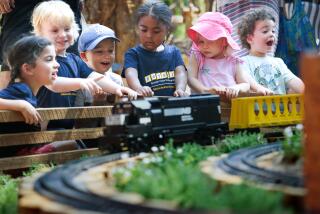New Jungle Sprouts Inside National Zoo
- Share via
WASHINGTON — It’s summer, and the hot breath of the nation’s capital throws a damp, sticky film over all who step outdoors.
But at the National Zoo’s new living rain-forest exhibit, Washington’s wilting summer weather feels like air-conditioning.
“It feels just the way it should for the tropics,” Zoo Director Michael H. Robinson says of the very humid, 24,000-square-foot habitat.
He should know.
Robinson spent 18 years as a tropical biologist at the Smithsonian’s Tropical Research Institute in Panama. He remembers what it felt like to have to wrap himself in a wet sheet to get to sleep in the heat at night. And in his cluttered zoo office, many of the books he brought back with him from Panama eight years ago still smell of must and mildew from the moist tropical air.
“I was lucky enough to live and work in the tropics, and to see the glory of the flora and fauna in the rain forest,” Robinson said. “Now we’re seeing the destruction of that glory.”
The Amazonia exhibit has been in the works for six years and is scheduled to open in November. Robinson hopes it will give visitors a real sense of why rain forests are so special.
To prepare for the grand opening, horticulturists are busy planting orchids and lush, leafy jungle vines under a collection of tropical trees shipped from Florida last month.
It took 4 1/2 hours to get one 40-foot mahogany tree into the building through an 8-foot opening in the roof. But it’s growing well now, along with many others. And there’s even a papaya tree and an avocado tree bearing fruit.
The new plants thrive in high humidity. So engineer Leo Carpentieri is keeping the building’s computerized temperature controls between 90 and 97 degrees. The humidity is 88% for now.
“Once the place opens up, it’ll be as high as we can get it,” Carpentieri says, his face aglow with sweat.
Carpentieri runs what’s known as the life-support system, a series of water filters, pumps and temperature controls that will help keep Amazonia’s flora and fauna alive.
Eventually, thousands of animal and plant species indigenous to the Amazon will occupy the habitat, enclosed under an enormous, translucent roof.
“The tropics are the Ft. Knox of the biological world. There’s so much diversity,” Robinson said. “So many species live so close together, and the interactions between them are so complex. There are moths so specialized that they drink the tears of other mammals.”
Visitors entering Amazonia will be greeted first by a waterfall, surrounded by a jungle-like green tangle of trees and plants. Up in the trees, monkeys will feed on fruit. And in a pool under the waterfall, fruit-eating piranhas and other fish will live off the bounty that lands in the water from above.
As they walk through a carpeted, tunnel-like room, visitors will get an underwater view of the Amazon, and the many fish that live in it, through large windows looking in on an enormous water tank.
Upstairs, on the building’s second floor, they will stroll through the forest itself. There’ll be toucans and honey creepers flying around, and sloths hanging from the trees. Frogs and lizards will be everywhere.
More to Read
Sign up for The Wild
We’ll help you find the best places to hike, bike and run, as well as the perfect silent spots for meditation and yoga.
You may occasionally receive promotional content from the Los Angeles Times.







